UK Oil & Gas Investments Plc (LON:UKOG) Chief Executive Officer Stephen Sanderson caught up with DirectorsTalk for an exclusive interview to discuss the latest flow test results from the Upper Kimmeridge limestones, what these results mean and what’s next for UKOG
Q1: Now more flow test news out, can you walk us through the latest results?
A1: Yes sure. Clearly the ‘Gatwick gusher’ has gushed quite a bit more, looks like we’ll have another 3 tankers of crude going from the site today and tomorrow. Just to recap, we basically have gone now to the second, the upper most of the Kimmeridge limestones, this is about 100 foot thick section, we perforated about 80 feet, that’s the zone that we shot holes through the steel casing to access the rocks containing the oil. Yesterday, sort of lunchtime, we put it on pump, a vertical rod pump, to try and induce the flow into the well, very very quickly it had actually started flowing naturally so we shut the pump down and basically it stabilised at 900 barrels, just slightly over 900 barrels of oil per day, and that was actually 100% oil, it was completely dry, there was no water. We flowed that until about 6:00 when we shut in and removed the rods and then basically we went back about 10:00 last night and then opened the well up again and it started flowing at similar rates so very high rates, twice as much as the zone below. I have to say again, to be honest, unexpectedly high but we’ll take that, I think according to our records this is actually the best natural flow rate from an on-shore exploration well actually in the history of the UK on-shore. The previous record holder I believe is Wytch Farm, that’s Europe’s largest on-shore oil field, and that found 640 barrels a day in the early 70’s, the next largest field Welton actually only produced 500 barrels a day on pump and that was 500 barrels a day in a production well which is optimised so this is very very significant in terms of a find in its own right. It’s very very significant also because it’s a find in a completely new rock formation and a completely new type of place so we’re very happy.
Q2: What do these results mean for the Kimmeridge play, the Weald Basin and for UK Oil & Gas Investments?
A2: Well I think, as I put in my RNS, I think that one might say that the first test result in the lower limestones, some people might have said well that’s a fluke they’ll never repeat that, but I think now we’ve shown that both the lower and the upper limestone contain moveable oil, very high quality, it flows very well, very high rates, simply from vertical wells. So I would say unequivocal proof that this play actually exists, I think the main take-away from it is the high rates so as I said before in my other interview, I think not only does this show that the play works but also shows that the play is actually commercial in terms of the rates that you can expect from a well. As for the Weald Basin, clearly as we’ve said before there is a lot of oil in the Kimmeridge and other rocks, but particularly in the Kimmeridge, over the whole of Weald Basin there’s about 80 billion barrels of oil in place in the whole section, about 20 billion in these limestones so for the Weald Basin itself it’s really very much a game-changer, there’s potentially a very significant amount of oil that can now be gotten out of the ground. Of course for us in wholesale development and UK Oil & Gas Investments, that’s very good news because we have quite a big chunk of the basin and clearly we’re now very very close to actual commercial reality, I think we never expected to be this close, I think that in the next couple of years you could see us actually producing commercial hydrocarbons as long as the oil price stays a little bit above where it is.
Q3: So what’s next for UK Oil & Gas Investments?
A3: I think I should have mentioned that one of the take-aways from this high rate is that clearly, in terms of commerciality, we’re going to be looking to try and get to commercial production as soon as possible. I think one of the main things to take away from these high rates is that they clearly give a much quicker payback than we ever thought, that improves the economics and clearly lowers the cost per barrel which makes it more robust to lower oil prices. It’s also quite possible now that the recovery could be much higher than the 5% target that we were mentioning in 2015, I mean other limestones in the United States like this actually recover nearly 10% so we could be looking at twice as much recovery. So to answer the ‘what next’, I think we now plan to get all of the regulatory permits in place to actually come back to this well, test the vertical well in the limestone zones and then we’ll do a horizontal sidetrack into one or possibly both of these and flow that over a long time. I think people should understand that a horizontal well generally results in quite a significant increase in flow rate and recovery, the rule of thumb as a minimum, it’s about a 3 times multiplier on the flow rate that you get from a vertical well so I think for us the future of this year is going to be heads down, doing a lot of field development planning and submitting plans to local authorities and the other regulatory bodies in the UK.


